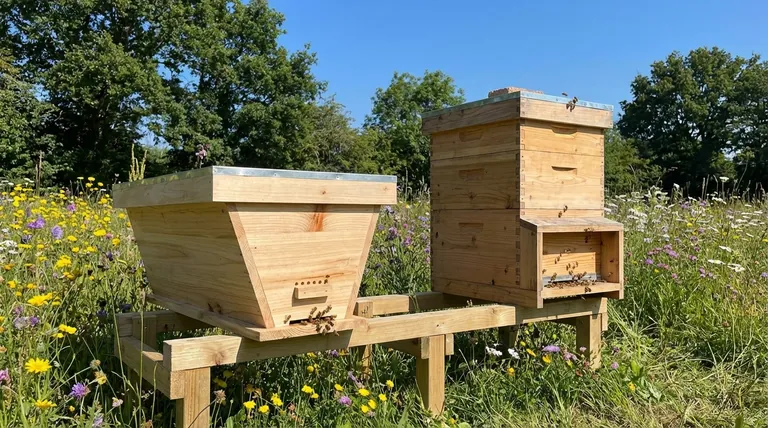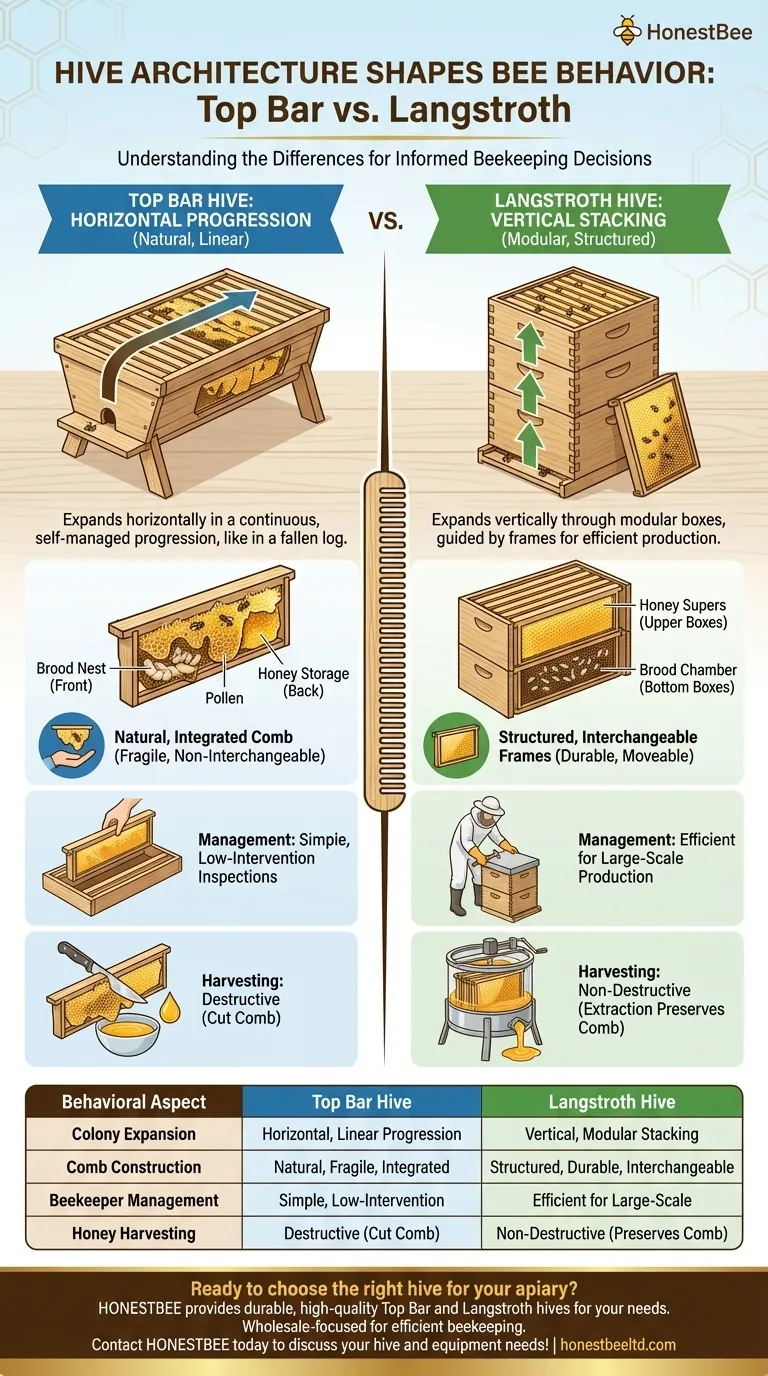The fundamental difference in bee behavior between a Top Bar and Langstroth hive is dictated entirely by the hive's architecture. Bees in a Top Bar Hive build their colony horizontally in a continuous, natural progression, much like they would in a fallen log. In a Langstroth hive, bees are guided to build vertically, filling modular boxes and frames in a structured, stackable manner controlled by the beekeeper.
A hive’s design is not just a box for bees; it is a blueprint for their behavior. Top Bar Hives encourage a linear, self-managed expansion, while Langstroth hives direct bees into a modular, vertical structure optimized for honey production and management intervention.

How Hive Architecture Shapes Colony Expansion
The core behavioral divergence stems from how bees perceive and utilize the space provided to them. This influences everything from comb construction to the colony's growth pattern.
The Horizontal Progression of a Top Bar Hive
In a horizontal Top Bar Hive, bees behave in a highly systematic and linear fashion. They begin building comb at one end (typically near the entrance) and expand horizontally down the length of the hive.
The queen establishes her brood nest in the first 10-15 combs. As the colony grows, worker bees build subsequent combs for pollen and, finally, honey storage. This creates a contiguous, ordered colony structure that expands naturally from front to back.
The Vertical Stacking of a Langstroth Hive
In a Langstroth hive, bees are compelled to think vertically. They fill the frames within a single box first, and once that space is nearly full, their instinct is to move upward into new territory.
The beekeeper facilitates this by adding more boxes (supers) on top. This modular design channels the bees' expansion into a vertical stack, allowing for a much larger potential colony size and more focused honey storage in designated upper boxes.
The Impact on Comb Construction
The use of bars versus frames creates a significant difference in how bees construct their comb, which in turn affects the beekeeper's management practices.
Natural, Integrated Comb
Top Bar Hives use simple wooden bars, encouraging bees to build their own comb without a foundation. This results in natural, often fragile, comb that is permanently attached to its top bar.
Because there are no frames, the bees build one continuous structure from the bar downwards, seamlessly integrating cells for brood, pollen, and honey as they see fit.
Structured, Interchangeable Frames
Langstroth hives use four-sided frames, which provide complete support for the comb. These frames often contain a foundation sheet that guides bees to build straight, uniform comb.
This structure makes the comb exceptionally durable and, most importantly, interchangeable. A beekeeper can easily move frames between boxes to manage colony strength or reconfigure the hive.
Understanding the Trade-offs
The behavioral patterns encouraged by each hive design create distinct advantages and disadvantages for the beekeeper.
Management Simplicity vs. Production Efficiency
The linear progression in a Top Bar Hive simplifies inspections; a beekeeper can examine the colony one bar at a time with minimal disturbance to the rest of the nest. However, its fixed horizontal size limits the colony's ultimate production capacity.
The Langstroth's vertical design is built for production efficiency. While inspections can require lifting heavy boxes, the system allows for near-limitless expansion and targeted honey harvesting from dedicated supers.
Harvesting Methods
In a Top Bar Hive, honey is harvested by cutting the entire comb off a bar. This method is simple and requires no special equipment, but it destroys the comb, forcing bees to rebuild it from scratch.
In a Langstroth hive, frames of honey are removed, and the honey is extracted using a centrifuge. This process preserves the valuable drawn comb, which can be returned to the hive, saving the bees significant energy and resources.
Making the Right Choice for Your Goal
Your choice of hive should be based on which set of bee behaviors aligns best with your beekeeping philosophy.
- If your primary focus is a natural, low-intervention approach: The Top Bar Hive is superior, as its design encourages the colony's self-regulated, linear expansion and allows for less disruptive management.
- If your primary focus is honey production and scalability: The Langstroth hive is the industry standard, as its modular design guides bees into a highly efficient structure for maximizing honey yields.
Ultimately, understanding these core behavioral differences empowers you to choose the hive that best serves both you and your bees.
Summary Table:
| Behavioral Aspect | Top Bar Hive | Langstroth Hive |
|---|---|---|
| Colony Expansion | Horizontal, linear progression | Vertical, modular stacking |
| Comb Construction | Natural, fragile, integrated comb | Structured, durable, interchangeable frames |
| Beekeeper Management | Simple, low-intervention inspections | Efficient for large-scale production |
| Honey Harvesting | Destructive (cut comb) | Non-destructive (extraction preserves comb) |
Ready to choose the right hive for your apiary?
Whether you manage a commercial operation or distribute equipment, HONESTBEE provides the durable, high-quality Top Bar and Langstroth hives and supplies your bees need to thrive. Our wholesale-focused operations ensure you get the right equipment for efficient, productive beekeeping.
Contact HONESTBEE today to discuss your hive and equipment needs!
Visual Guide

Related Products
- Top Bar Beehive for Beekeeping Wholesales Kenya Top Bar Hive
- Long Langstroth Style Horizontal Top Bar Hive for Wholesale
- HONESTBEE Professional Long Handled Hive Tool with Precision Cutting Blade
- HONESTBEE Professional Multi-Functional Hive Tool with Ergonomic Wood Handle
- HONESTBEE Advanced Ergonomic Stainless Steel Hive Tool for Beekeeping
People Also Ask
- What are the benefits of a top bar hive? A Natural, Low-Impact Approach to Beekeeping
- Which is better Kenya top bar hive or Langstroth? Choose the Right Hive for Your Goals
- Why are hive inspections easier with Top Bar Hives? Achieve a Calmer, Safer Approach to Beekeeping
- What are the labor requirements for a KTBH vs. Langstroth hive? A Guide for Apiary Efficiency
- How is honey harvested from a top-bar hive? A Guide to Simple, Low-Equipment Processing



















